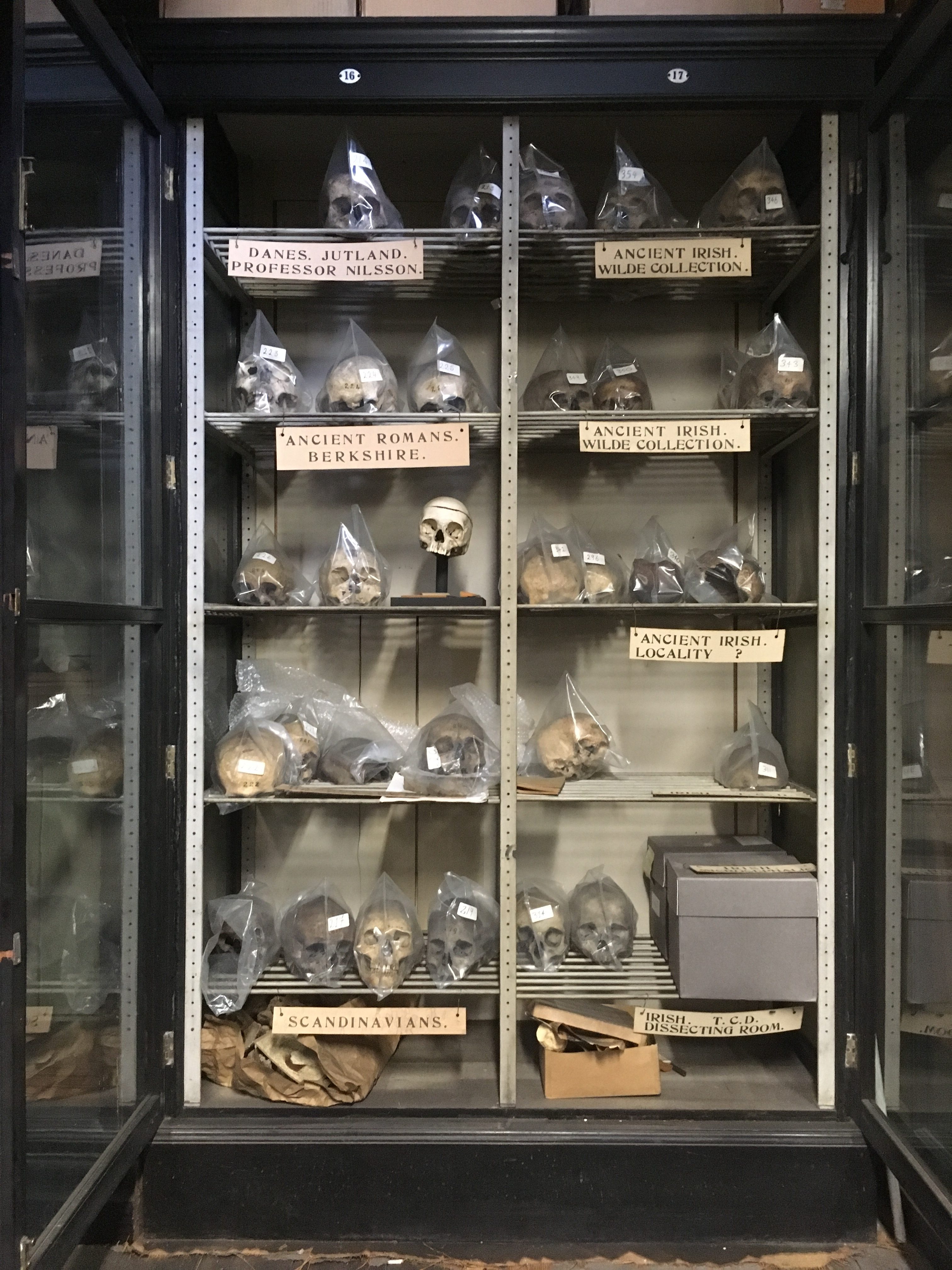
Going Wilde in “Old” Anatomy. William Wilde’s collection of skulls goes on display in TCD as a backdrop for the filming of “Growing, Up Live”
The skulls have been taken out of storage and put on display as the “Old” Anatomy Museum in TCD goes “live” for three nights during Science Week 2018. The Museum has been transformed into a studio for Growing Up, Live. It is being filmed in front of a live studio audience and the programme makers will “be treating the audience to live science experiments every night” which, RTE promises, “will unlock our understanding of a human lifetime.’
The Anatomy Museum is a really interesting setting for a show like this. Historically, dissections were done in front of a live audience. That won’t happen in “Growing Up, Live” but the audience will be surrounded by the results of 300 years of anatomical research. The Museum is home to a collection of anatomical and medical specimens that was built up over 300 years of medical education in Trinity College, University of Dublin, much of which was “re-discovered” when “Old” Anatomy Dept was decommissioned in 2014 and the School of Medicine move to the TBSI building on Pearse St.

Angela Scanlon adopts the traditional pose of the Anatomist – skull in hand – in “Old” Anatomy in preparation for the filming of “Growing Up, Live.”
The live broadcast marks a turning point in the process of opening the least known and most interesting museum in Dublin to the public. In March 2017, Joe Duffy created some controversy when he called for the skeleton of Cornelius Magrath, the Irish Giant, to be removed from display in the mistaken belief the Magrath’s body had been robbed, dissected in secret, and his skeleton put on display in 1760. I was working on the collection at the time and found evidence that Magrath had in fact been in the care of Trinity School of Medicine when he died.
The controversy died but there was a some nervousness about opening the collections to the public as a result. Brendan Holland, another Irish Giant, came to the rescue. He filmed part of the documentary “The Giant Gene” in the Anatomy Museum and went public on the most difficult question of all: as a giant, how would he feel it his skeleton was put on display? Brendan didn’t have a problem with that, given the contribution that historic specimens like Magrath continue to make to medical research into conditions like gigantism.

2018. Public engagement at work: BBC Northern Ireland recording an interview between Brendan Holland and Martina Hennessy (School of Medicine TCD) for the a documentary entitled “The Giant Gene.” It was produced by Chris Nikkel and broadcast in June 2018.

2016. The Anatomy Museum operating as a mixture of conservation workshop and anthropological “field.” This is some of the material that was discovered in 2014 and needed to be sorted, catalogued, and stored in preparation for conservation and display. The anthropological material is visible in the foreground.
The use of the space as a studio marks another turning point. An enormous amount of material was discovered in the process of decommissioning the “Old” Anatomy Dept in 2014. Much of this was in tea-chests and crates but there was a lot of material stored under the old theatre and in every nook and cranny of the building. This included a really important collection of photographs taken in the Aran Islands in 1890, shortly before the Anatomy Dept established a small Anthropology Dept and opened an anthropometric (the measurement of humans) laboratory.

A photograph taken by Andrew F. Dixon and Alfred Cort Haddon in Dún Chonnchubhair, Inis Meáin, in 1890. The negative on the left still has the masking that was used to create the effect of a clear sky. The image on the right is an inverted scan of the original, which is called a positive.
That is where curator.ie got involved. I received funding from the Irish Research Council (research.ie) to work on collections associated with the Anthropometric Laboratory and its programme of ethnographic surveys in the west of Ireland. The project was a joint venture of Maynooth University, TCD School of Medicine, and Kimmage Development Studies Centre, now Shanahan Research Centre.
As a curator and a student of anthropology, I did my fieldwork in “Old” Anatomy. Most of the material discovered in 2014 was stored in the Anatomy Museum and it took the best part of two years to go through it and organise suitable storage in the nooks and crannies from whence it came. The plan, all along, was to restore the museum as a public space.
The filming of “The Giant Gene” was a key part of a strategy to make the collection visible and to engage the public in a conversation about the contemporary significance of “Old” Anatomy, whether that is the Skeleton of Magrath, the huge range of medical education material, or the ethnographic material associated with the Anthropological Dept.
The filming of “Growing Up, Live” is on a different scale altogether, given the reach of Science Week and the presence in the museum of a studio audience. RTE publicists have described the “studio” as an amazing Anatomy Museum” and it will be very interesting to see how the audience engages with the various collections.
This is the space to watch during Science Week.

The history of the British Isles as represented in skulls. Ethnologists in the mid-nineteenth century believed that they could find traces of the various invasions of Ireland by comparing the shape of ancient skulls.
To Follow: The Skull Measuring Business: the work of the Dublin Anthropometric Anthropometric Laboratory (1891-1903).
